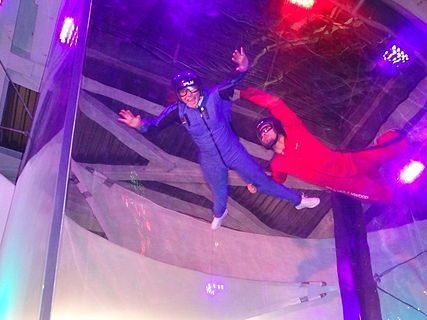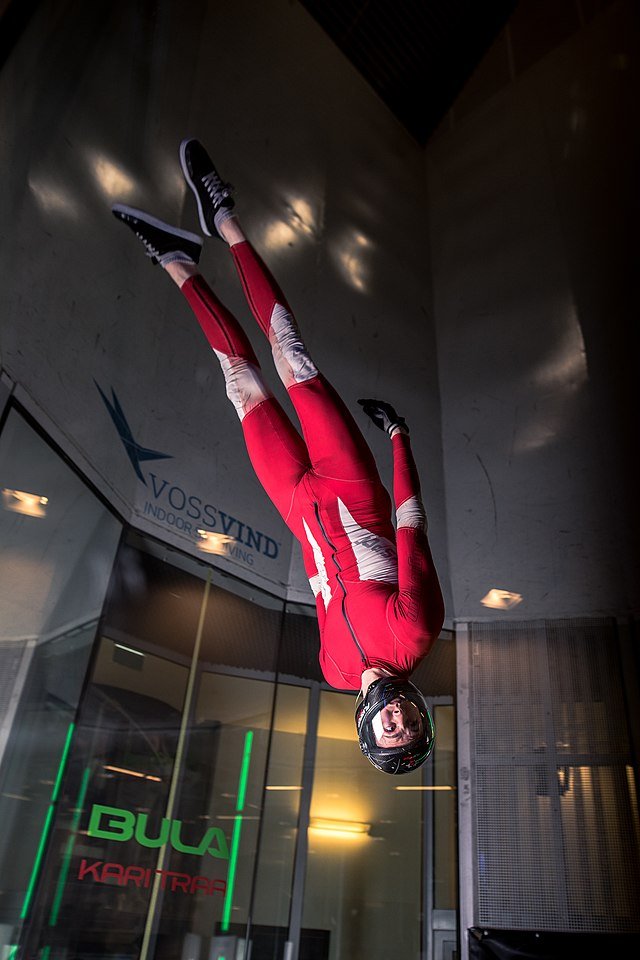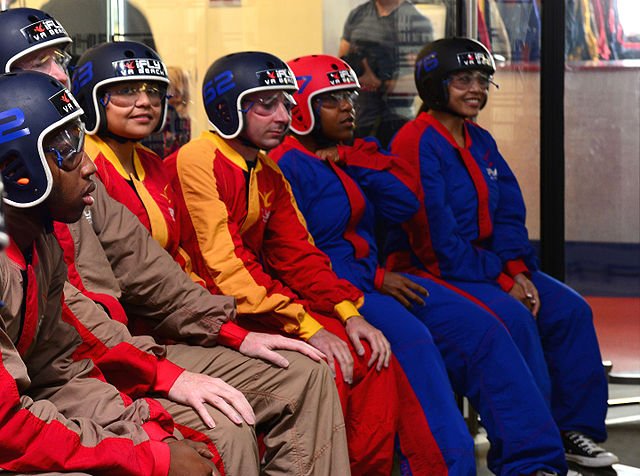Indoor skydiving has been booming since the mid-2010s. Companies like iFly and XP are great for getting the thrill of skydiving without flying two miles above the earth. It’s also A LOT cheaper and lasts roughly the same amount of time (60 seconds).
Still, before jumping into a wind tunnel, it’s important to ask if indoor skydiving is safe.
We’re happy to reassure you. Indoor skydiving is a very safe yet exciting activity.
Is indoor skydiving safe?
Indoor skydiving is extremely safe. Out of millions of flights each year, less than 0.03% end with injuries.
Before every flight, the staff will give you the necessary safety equipment: a helmet, goggles, and a flight suit. The safety gear might make you look cool, but it will protect your head and eyes.
In every first flight, an instructor provides important safety assistance. They help you to be stable while floating.
The instructor shows you how to stay still, turn, and go up and down while making sure they can help control your body.
Accident do happen, but having the instructor really does help ensure a great deal of safety. Look at this video for example where a man is skydiving for the first time, loses a bit of control, and the instructor catches him.
As you might have guessed, indoor skydiving is much safer than skydiving from a plane. About 1 in 1,537 plane skydives end in injury.
If someone does suffer an injury from indoor skydiving, it most likely will be related to a muscle tear or dislocation of a shoulder joint.
If you have previously dislocated your shoulder, are double jointed or have ligamentous laxity you should probably not try indoor skydiving or at the very least, you should consult with your doctor before scheduling a flight.
Another issue are heart conditions. If you have a heart condition, it is advised that you do not try indoor skydiving. The activity is high stress and can increase your chance for stroke during the flight.
Can I get injured while indoor skydiving?
The short answer is yes, injuries have occured while indoor skydiving. However, injuries are very rare.
A prominent indoor skydiving company, iFly, said out of a million flights, only one jump ends in injury. That is a really good track record; much better than
Some people are sceptical however. They point out there are not as strict regulations in place for indoor skydiving as for rollercoasters.
One woman had what seemed like a normal tear injury but turned out to be ligamentous laxity which required surgery. She ended up spending $40,000 in medical bills, but this is an extremely rare occasion.
Horror stories aside, it’s important to know indoor skydiving is relatively safe as an activity. It gives you similar adrenaline as jumping out of a plane but with less risk and no expensive parachute required.
Is Indoor skydiving safe while pregnant?
While you may be able to fly while pregnant, companies advise against people pregnant flying.
Unfortunately, there are always risks with any activity even one with such a good safety record as indoor skydiving.
For example, what does a blast of 100 mph wind do to a person who is pregnant? You could also hit the plexiglass while flying or fall while exiting the chamber.
It is best to be safe. That is why it is not recommended to indoor skydive while pregnant.
It should be said pregnant people are not allowed to skydive out of a plane either unless they have a professional licence.
Some people have gone skydiving while pregnant without any ill effects.

Can you die from indoor skydiving?
Any sport or ride entails risk of death like rollercoasters or even driving a car. Luckily, indoor skydiving is extremely safe.
There has only been one documented death while indoor skydiving, but it was due to a medical condition, not a flight accident.
In the extremely rare case, a professional indoor skydiver died while doing advanced manoeuvres because of a condition where his brain could haemorrhage at any time.
That’s why it is incredibly important to know the state of your body before going indoor skydiving. You need to know any conditions you might have, and what effect a high intensity activity might have on you.
If you have any concerns, speak with your doctor. You can ask about any conditions you may have which could be complicated by an exciting (for some stressful) experience such as indoor skydiving.
As you might have guessed, skydiving from a plane is riskier than indoor skydiving. 1 in 100,000 flights ends in death and different skydiving companies can have varying levels of safety. Still, one in one hundred thousand aren’t bad odds in the grand scheme of things.
Is it safe for children to indoor skydive?
Yes! Children ages 3 and over can indoor skydive.
Some suggest starting at the age of 4 just so your child has a bit more weight.
Staff can adjust the wind tunnel’s speedsto fit smaller as well as bigger bodies.
If you’re interested in what kids indoor skydiving looks like, here’s a short video capturing the entire flight experience.
Like with an adult, the instructor very carefully holds on to the children, not letting them fall or fly up too fast.
You may notice that children seem to have more trouble controlling their bodies than adults. This is probably because of their underdeveloped leg and arm muscles.
It’s important for the children to focus on the instructional videos before entering the tunnel. It’s also important they listen to and trust the instructor.
And of course, it’s important to check that your child wants to do indoor skydiving before booking or flying.
It’s helpful to tell your child that indoor skydiving can feel like swimming which can give them a good point of reference for what the experience may feel like.
Is it safe to indoor skydive if I am disabled?
Disabled people can enjoy the thrill of indoor skydiving just like anyone else.
While it each disability differs greatly, lot of disabled people can and do indoor skydiving.
In Atlanta, Georgia, there’s a group disabled people with spinal cord damage who go indoor skydiving together.
They can still fly like anyone else, but with two instructors rather than one to hold them steady and for safety.
Is it safe to indoor sky dive if I have an injury?
As far as injuries are concerned (not disabilities), the type of injury is crucial.
Indoor skydiving can worsen any dislocation, especially in the shoulders. Most companies do not allow or suggest people with shoulder injuries to fly.
When in doubt, it is best to consult with your doctor before doing any strenuous activity.
Is it safe to indoor skydive while intoxicated?
While it isn’t written specifically in their rules, indoor skydiving while being intoxicated is a very bad idea.
Being intoxicated makes everything riskier like driving, exercising, even walking, so it’s best not to go into the tunnel with wind speeds over a 100 mph.
You might feel like Superman while drunk in a wind tunnel, you may even fly like him, but you aren’t quite as durable as the Man of Steel.

Is indoor skydiving worth the risk?
Every activity has some risks, sports, driving or even just taking a stroll, but indoor skydiving is a relatively safe way to get a big adrenaline rush.
Indoor skydiving is one of the only ways to feel weightless on earth. It can be the experience of a lifetime.
If you’re still worried after reading this, please check out some videos of amateur and professional indoor skydivers. It really helps to see the process before going through it.
Safety is crucial to having a great fun experience. Remember, companies designed indoor skydiving to provide an exhilarating activity while being extremely safe.

